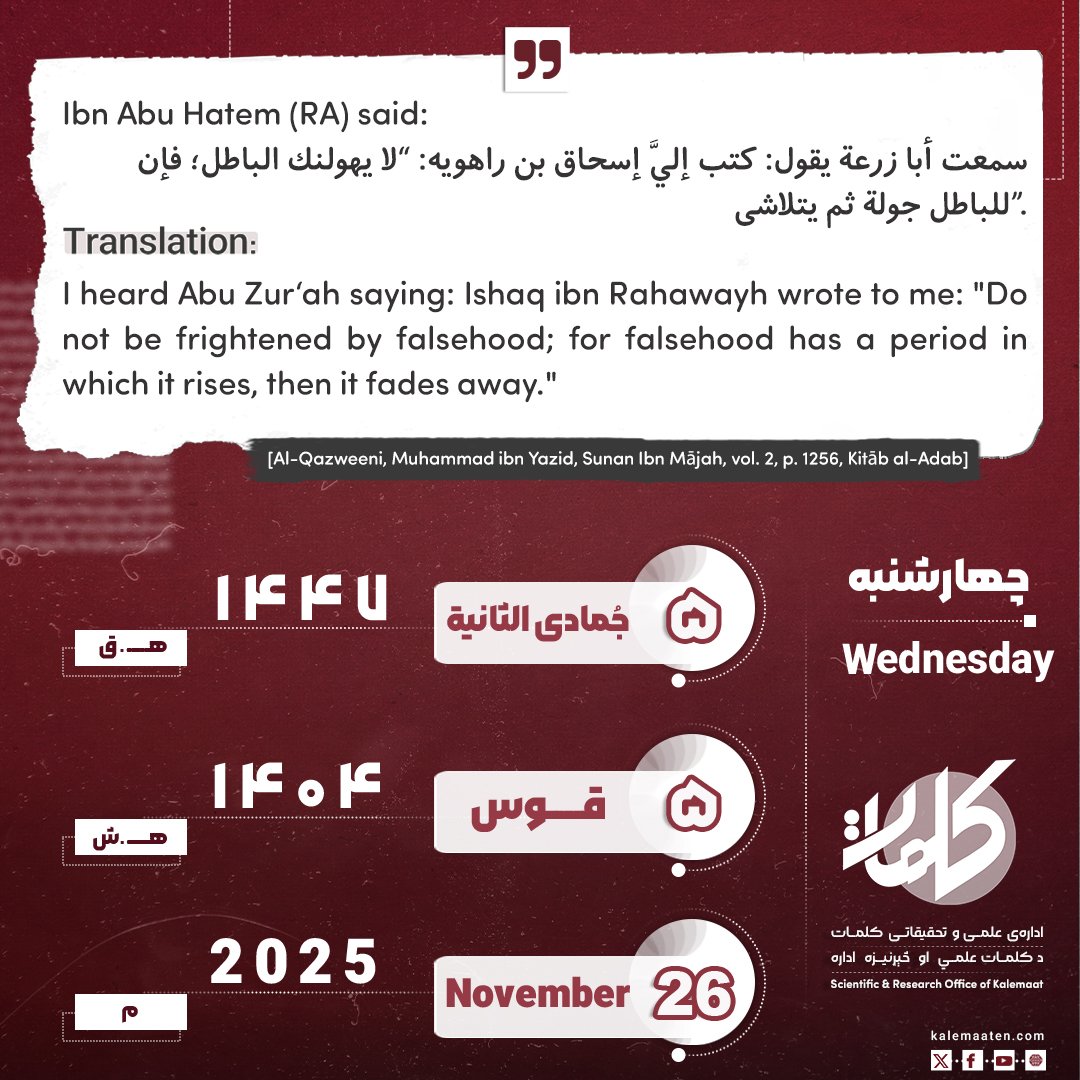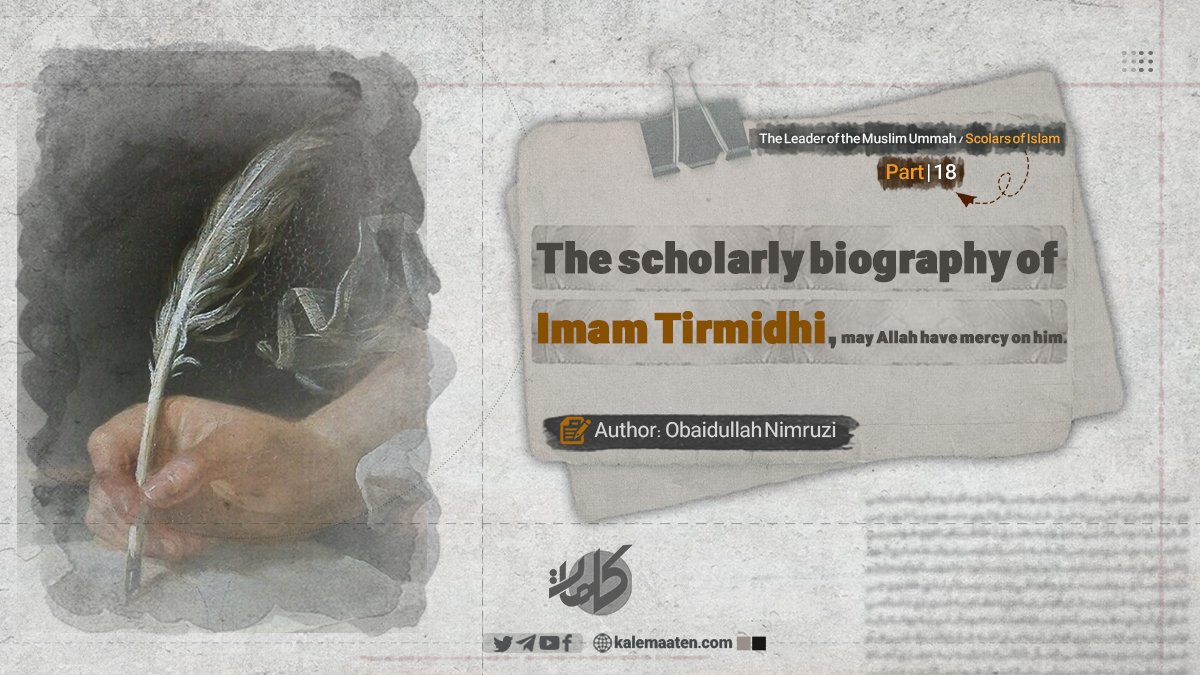Author: Obaidullah Nimruzi
The Scholarly Biography of Imam Tirmidhi ‘may Allah have mercy on him’ (The 18th and Final Part)
Compiling Hadith in the Third Century of the Hijri
The work of compiling Hadith reached a high level of maturity during this century. Long chains of transmission and hadiths were narrated in various ways, and with the novelty of the science of hadith, many new books with different arrangements and chapters were created. During this period, hadith literature was divided into more than twenty categories. At this stage, hadith books were written, and the science of hadith criticism and the study of the names of transmitters became independent, leading to the creation of numerous works.
Among the hadith books compiled in the third century of the Hijri, the following can be highlighted:
1. Musnad Abu Dawud al-Tayyalisi: This book, written in the third century of the Hijri, is regarded as one of the most important sources of hadith.
2. Musnad Ahmad (may Allah have mercy on him): Compiled by Imam Ahmad ibn Hanbal (may Allah have mercy on him), this book is one of the greatest sources of hadith for Sunnis, containing various narrations across many fields.
3. Musnad Abdul Razzaq (may Allah have mercy on him): One of the most reliable collections, compiled by Abdul Razzaq ibn Hammam (may Allah have mercy on him).
4. Musnad Abu Bakr ibn Abi Shaybah (may Allah have mercy on him): Another reliable source of hadith, compiled by Abu Bakr ibn Abi Shaybah (may Allah have mercy on him), which includes a range of narrations from different sources.
5. Mustadrak al-Hakim (may Allah have mercy on him): Compiled by Hakim al-Nishaburi (may Allah have mercy on him), this book contains hadiths that he considered authentic but not included in other collections.
6. Mo’jam al-Tabarani (may Allah have mercy on him): Compiled by Tabarani (may Allah have mercy on him), it is a critical source of hadith that organizes narrations based on the names of the companions (may Allah be pleased with them).
7. Musnad al-Bazzar: A reliable collection compiled by Bazzar (may Allah have mercy on him).
8. Musnad Abi Ya’li: Compiled by Abi Ya’li (may Allah have mercy on him), it includes a variety of hadiths from numerous sources.
9. Musnad al-Darimi: Another significant hadith book written by Darimi (may Allah have mercy on him), containing a compilation of authentic and trustworthy hadiths.
10. Sunan al-Kobra al-Bayhaqi: A reputable jurisprudential and hadith book compiled by Imam Bayhaqi (may Allah have mercy on him), which includes a collection of hadiths.
11. Sunan Dar Qatani: Compiled by Dar Qatani (may Allah have mercy on him), this book features hadiths from the Prophet (peace and blessings of Allah be upon him) that he believed were not mentioned in other texts.
General Conclusion
The science of hadith, one of the fundamental foundations of religious knowledge in Islam, has always held a special place and played a vital role in shaping Islamic jurisprudence and elucidating religious teachings. Various scholars’ definitions of hadith, which delineate the boundaries of this field, reflect differing attitudes toward the accuracy and scope of religious sources. Given that the hadith of the Prophet (peace and blessings of Allah be upon him) serves as a primary source for deriving religious and jurisprudential rulings, its rigorous and scholarly examination is essential.
The science of hadith employs scientific and historical methods, especially in the fields of genealogy, Jarh (criticism) and Tahdil (verification), ensuring the preservation and accurate transmission of the Prophet’s hadiths (peace and blessings of Allah be upon him). It also addresses various doubts and objections regarding their authenticity and reliability. Ultimately, hadith studies must be recognized and explored as an independent and critical field. This discipline not only enriches our understanding of Islamic teachings but also responds to new religious challenges and needs across different eras. In light of the religious and scientific developments in Islamic societies, the need for meticulous narration and correct understanding of hadith has never been greater.
To attain an accurate understanding of hadith and its authenticity, it is essential for hadith scholars to employ precise scientific tools such as genealogy, Jarh and Tahdil, as well as a rigorous critique of both the chain of transmission and the text itself. Furthermore, attention must be given to the semantic and conceptual variations within hadith terminology to prevent potential misunderstandings. By maintaining diligence in examining sources and texts, the science of hadith can safeguard itself against distortions and misinterpretations.
It is also paramount to emphasize the significance of the relationship between hadith and the Quran. In many instances, hadith complements and clarifies the Quran; without a proper understanding of hadith, many Quranic concepts cannot be fully appreciated. Consequently, hadith studies should always be integrated with Quranic interpretation and Islamic jurisprudence. By aligning these sources, the pathway to deriving religious and jurisprudential rulings can be clearly and reliably articulated.
Lastly, it is important to acknowledge the diversity of views and discussions in hadith studies, including differing definitions of hadith, its authenticity, and its influence on Islamic jurisprudence. Careful and ongoing examination of this subject will enable optimal utilization of this science and facilitate a comprehensive and accurate understanding of religious teachings. This understanding is not only instrumental in fostering scientific growth within Islamic society, but also plays a fundamental role in achieving high religious and moral objectives.
As a result, the science of hadith, with its rich and diverse resources, continues to be recognized as a crucial pillar of religious and Islamic sciences. The necessity for careful attention and study of this field across all religious and jurisprudential domains can thus be emphasized.
[1]. Musnad Abu Dawood Tayalisi, Dar Al-Kutub Al-Ilmiyyah, 1414 Hijri Qamari.
[2]. Musnad Ahmad ibn Hanbal, Dar Al-Fikr, 1399 Hijri Qamari.
[3]. Musannaf Abdul Razzaq, Dar Al-Kutub Al-Ilmiyyah, 1412 Hijri Qamari.
[4]. Musannaf Abu Bakr ibn Abi Shaybah, Dar Al-Kutub Al-Ilmiyyah, 1400 Hijri Qamari.
[5]. Mustadrak Hakim, Hakim Nishapuri, Dar Al-Kutub Al-Ilmiyyah, 1425 Hijri Qamari.
[6]. Al-Mu’jam Al-Kabir, Tabarani, Dar Ihya Al-Turath Al-Arabi, 1413 Hijri Qamari.
[7]. Musnad Al-Bazzar, Bazzar, Dar Al-Fikr, 1416 Hijri Qamari.
[8]. Musnad Abu Ya’la, Dar Al-Fikr, 1420 Hijri Qamari.
[9]. Musnad Al-Darimi, Dar Al-Fikr, 1400 Hijri Qamari.
[10]. Al-Sunan Al-Kubra, Bayhaqi, Dar Al-Fikr, 1410 Hijri Qamari.
[11]. Sunan Al-Dar Qutni, Dar Al-Kutub Al-Ilmiyyah, 1403 Hijri Qamari.



